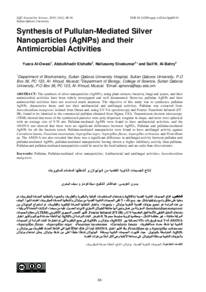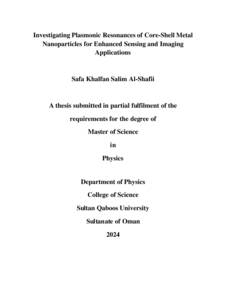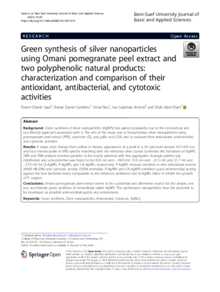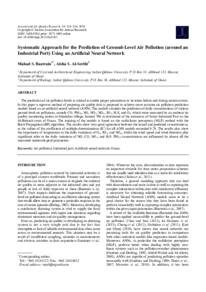وثيقة
Synthesis of pullulan-mediated silver nanoparticles (AgNPs) and their antimicrobial activities.
المعرف
DOI:10.24200/squjs.vol24iss2pp88-94
المصدر
Sultan Qaboos University Journal for Science. v. 24, no. 2, p. 88-94.
المساهمون
عناوين أخرى
إنتاج الجسيمات النانويه الفضيه من البوليولان و أنشطتها المضاده للمكيروبات.
الدولة
Oman.
مكان النشر
Muscat.
الناشر
College of Science, Sultan Qaboos University.
ميلادي
2019-01-19
اللغة
الأنجليزية
الملخص الإنجليزي
The synthesis of silver nanoparticles (AgNPs), using plant extracts, bacteria, fungi and yeasts, and their antimicrobial activities have been widely investigated and well documented. However, pullulan AgNPs and their antimicrobial activities have not received much attention. The objective of this study was to synthesize pullulan AgNPs, characterize them, and test their antibacterial and antifungal activities. Pullulan was extracted from Aureobasidium mangrovei isolated from Oman and, using UV-Vis spectroscopy and Fourier Transform Infrared (FT-IR), found to be identical to the commercial pullulan obtained from Sigma, USA. Transmission electron microscopy (TEM) showed that most of the synthesized particles were poly-dispersed, irregular in shape, and most were spherical with an average size of 9.76 nm. Pullulan-mediated AgNPs were found to have antibacterial activities, and the ANOVA test showed that there were no significant differences between AgNO3, Pullulan and pullulan-mediated AgNPs for all the bacteria tested. Pullulan-mediated nanoparticles were found to have antifungal activity against Curvularia lunata, Fusarium incarnatum, Aspergillus niger, Aspergillus flavus, Aspergillus ochraceus and Penicillium sp. The ANOVA test also revealed that there was a significant difference in antifungal activity between pullulan and pullulan-mediated AgNPs, pullulan-mediated nanoparticles having shown a higher inhibitory activity than pullulan. Pullulan and pullulan-mediated nanoparticles could be used in the food industry and are safer than silver nitrates.
ISSN
2414-536 X
الملخص العربي
لقد تمت دراسة تخليق جسيمات الفضة النانوية (AgNPs)، باستخدام المستخلصات النباتية والبكتيريا والفطريات والخمائر، وأنشطتها المضادة للميكروبات على نطاق واسع وتوثيقها جيدًا. ومع ذلك، فإن AgNPs pullulan وأنشطتها المضادة للميكروبات لم تحظ بالكثير من الاهتمام. كان الهدف من هذه الدراسة هو تصنيع بوليولان AgNPs وتوصيفها واختبار نشاطها المضاد للبكتيريا والفطريات. تم استخلاص البولولان من Aureobasidium mangrovei المعزول من عمان، وباستخدام التحليل الطيفي للأشعة فوق البنفسجية وتحويل فورييه للأشعة تحت الحمراء (FT-IR)، وجد أنه مطابق للبولولان التجاري الذي تم الحصول عليه من سيجما، الولايات المتحدة الأمريكية. أظهر المجهر الإلكتروني النافذ (TEM) أن معظم الجزيئات المحضرة كانت متعددة المشتتة، وغير منتظمة الشكل، وكان معظمها كرويًا بمتوسط حجم 9.76 نانومتر. تم العثور على AgNPs بوساطة بولولان لها أنشطة مضادة للبكتيريا، وأظهر اختبار ANOVA أنه لا توجد فروق ذات دلالة إحصائية بين AgNO3 وPullulan وAgNPs بوساطة بولولان لجميع البكتيريا التي تم اختبارها. تم العثور على الجسيمات النانوية التي تتوسط البولولان لها نشاط مضاد للفطريات ضد Curvularia lunata و Fusarium incarnatum و Aspergillus niger و Aspergillus flavus و Aspergillus ochraceus و Penicillium sp. كشف اختبار ANOVA أيضًا عن وجود اختلاف كبير في النشاط المضاد للفطريات بين AgNPs والبولولان بوساطة البولولان، حيث أظهرت الجسيمات النانوية بوساطة البولولان نشاطًا مثبطًا أعلى من البولولان. يمكن استخدام البولولان والجسيمات النانوية التي تتوسطها البولولان في صناعة المواد الغذائية وهي أكثر أمانًا من نترات الفضة.
قالب العنصر
مقالات الدوريات





